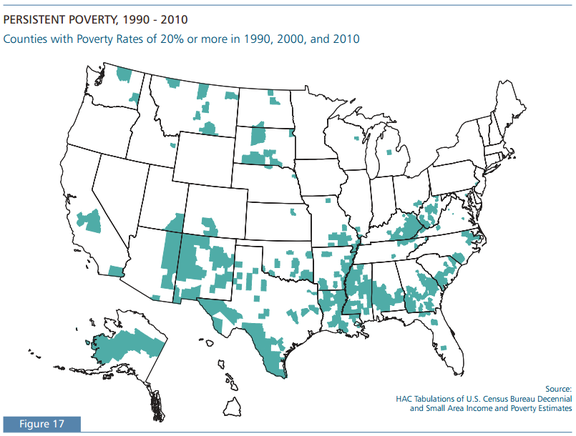The Housing Assistance Council (HAC) recently released a report about the state of people, poverty, and housing in small town America. It's full of great data, but most jarring to me was that showing counties that have experienced persistent poverty continuously since 1990. Yet another angle to the same story - if you're a non-white person living in a small town in America, chances are high you're living in poverty or in danger of falling back into poverty.
I'll let them take it away:
An increasing number of rural communities are experiencing persistently high poverty rates. These areas are often isolated
geographically, lack resources and economic opportunities, and suffer from decades of disinvestment. Often forgotten or
hidden from mainstream America, these areas and populations have had double-digit poverty rates for decades.
Persistently poor counties are those with poverty rates of 20 percent or more in 1990, 2000, and 2010. There were 429 of
these persistently poor counties in 2010. Fully 86 percent of them had entirely rural populations.
Overall, more than 21 million people live in persistent-poverty counties. Nearly 60 percent of them are racial and ethnic
minorities, and the median household income is $31,581, more than 40 percent below the national median. More than
5 million people live below the poverty line in these counties, with an overall poverty rate of 25 percent – nearly twice the
national rate. The poverty rate for minorities in these communities is even higher, at 32 percent.
One highly visible outcome of this economic distress can be seen in these areas’ poor housing conditions. The incidence
of housing units lacking adequate plumbing is more than twice the national rate, and nearly 400,000 households in these
regions live in crowded conditions. Additionally, while housing costs are relatively low in many of these communities, more
than half of renters in persistent-poverty counties encounter affordability problems and pay more than the federal standard
of 30 percent of income for their housing.
The persistence of poverty is most evident within several predominately rural regions and populations such as Central
Appalachia, the Lower Mississippi Delta, the southern Black Belt, the colonias region along the U.S.-Mexico border, Native
American lands, and migrant and seasonal farmworkers. One of the more distressing trends is that the number of persistent poverty counties is actually increasing. Using the same benchmark, the number of persistent-poverty counties increased by 8 percent from the 2000 level.


 RSS Feed
RSS Feed
